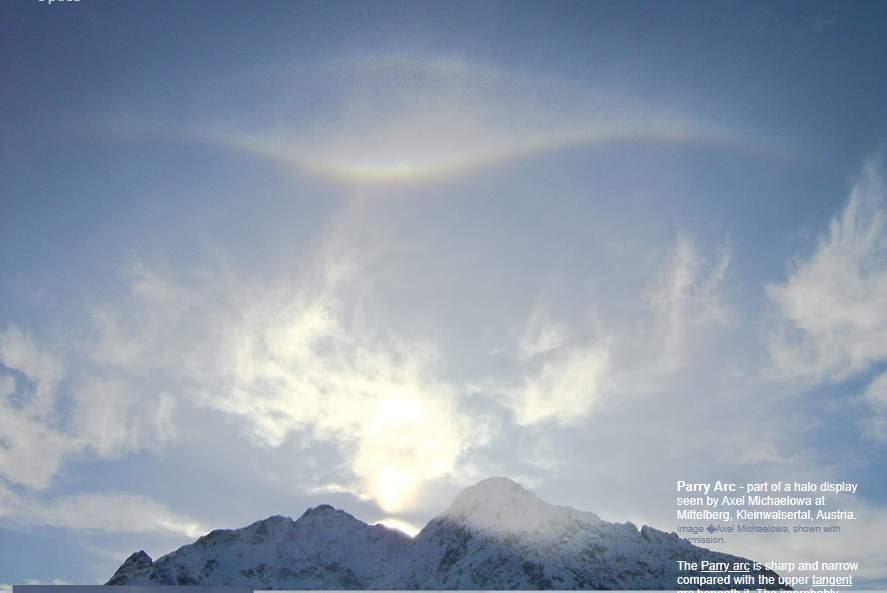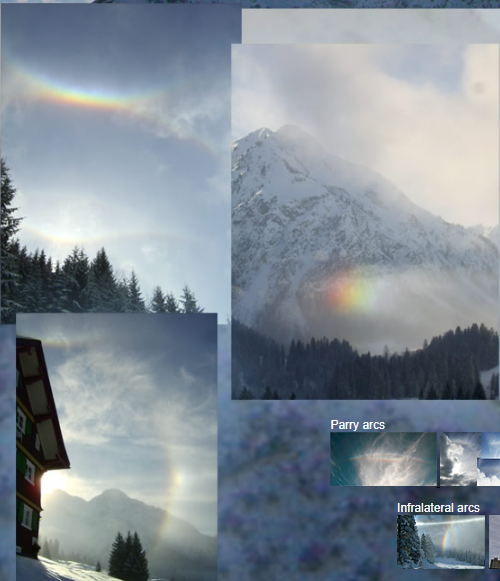Parry Arc
Parry Arc: Exploring the Enigmatic Halo Phenomenon
Halo displays in the sky have always fascinated skywatchers, and one of the intriguing optical phenomena that can be observed is the Parry arc. Named after the British Arctic explorer William Edward Parry, this arc is a sharp and narrow band of light that appears above the horizon. It is often seen in conjunction with other halos, creating a mesmerizing spectacle in the sky.
Understanding the Parry Arc
The Parry arc is distinct from the upper tangent arc located beneath it. While the upper tangent arc appears wider and less defined, the Parry arc stands out with its precise alignment and narrowness. This phenomenon occurs due to the unique orientation of ice crystals in the atmosphere, which act as prisms, deflecting sunlight and creating this distinct arc.
The Formation of Parry Oriented Crystals
To fully grasp the formation of the Parry arc, it's essential to understand the intricate nature of ice crystals in the atmosphere. These tiny ice particles, shaped like hexagonal prisms, play a crucial role in the creation of various atmospheric optical phenomena. The Parry arc specifically forms when these ice crystals align themselves in a specific way, creating a consistent orientation that produces rays deflected as if from a fixed prism.
Crystal Rotational Positions
In contrast to the Parry arc, the upper tangent arc below it is composed of rays that result from a mixture of many crystal rotational positions. This blending of orientations gives the upper tangent arc a broader appearance compared to the sharpness of the Parry arc. The combination of these two arcs adds depth and complexity to the overall halo display, captivating observers with its intricate interplay of light and ice crystals.
A Symphony of Halos
When observing the Parry arc, one is often treated to a symphony of other halos that further enhance the celestial spectacle. These include the circumzenithal arc, which can sometimes intersect with the supralateral arc, creating an ethereal connection between these two phenomena. Additionally, sundogs, a 22-degree halo, and a complete parhelic circle may also be visible, each contributing to the mesmerizing display in the sky.
The Infralateral Arc Fragment
In certain atmospheric conditions, such as when observing from lower elevations in mountainous regions, one might catch a glimpse of an infralateral arc fragment. This phenomenon appears low in the mountains and adds an extra layer of intrigue to the already captivating halo display. The infralateral arc fragment is yet another example of how atmospheric conditions and crystal orientations can combine to create unique and stunning optical effects.
Unveiling the Mysteries
While much has been discovered about the Parry arc and other atmospheric optical phenomena, there is still much to learn. Scientists continue to study the intricacies of ice crystal formation, orientation, and light refraction to unlock the secrets behind these captivating displays in the sky. The more we understand about these phenomena, the better equipped we become to appreciate and interpret the beauty of nature's optical wonders.
Conclusion
The Parry arc, with its sharpness and precise alignment, is a captivating element within the realm of atmospheric optics. It is a testament to the delicate interplay between ice crystals and sunlight, showcasing the incredible complexity of nature's phenomena. When observing the Parry arc, one becomes immersed in a world of halos, arcs, and circles, each contributing to a visual symphony that never fails to awe and inspire. As we continue to explore and understand these enigmatic displays, we deepen our connection to the natural world and gain a greater appreciation for its wonders.

Parry Arc - part of a halo display seen by Axel Michaelowa at Mittelberg, Kleinwalsertal, Austria. Image �Axel Michaelowa, shown with permission.
The Parry arc is sharp and narrow compared with the upper tangent arc beneath it. The improbably precise alignment of Parry oriented crystals produces rays deflected as from a fixed prism. Those from the tangent arc are mixtures of many crystal rotational positions.
Other halos were visible incuding a circumzenithal arc touched by a supralateral arc, sundogs, a 22 degree halo and a complete parhelic circle. Low in the mountains there was possibly a fragment of an infralateral arc.

Note: this article has been automatically converted from the old site and may not appear as intended. You can find the original article here.
Reference Atmospheric Optics
If you use any of the definitions, information, or data presented on Atmospheric Optics, please copy the link or reference below to properly credit us as the reference source. Thank you!
-
<a href="https://atoptics.co.uk/blog/parry-arc/">Parry Arc</a>
-
"Parry Arc". Atmospheric Optics. Accessed on November 24, 2024. https://atoptics.co.uk/blog/parry-arc/.
-
"Parry Arc". Atmospheric Optics, https://atoptics.co.uk/blog/parry-arc/. Accessed 24 November, 2024
-
Parry Arc. Atmospheric Optics. Retrieved from https://atoptics.co.uk/blog/parry-arc/.